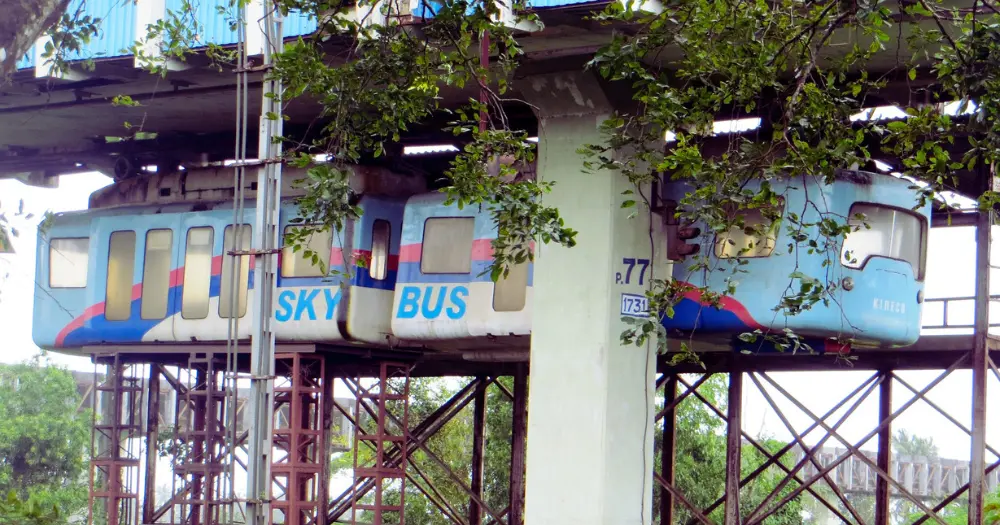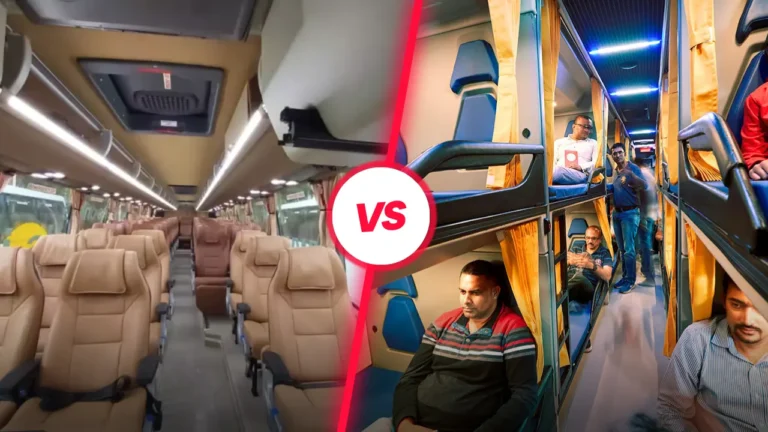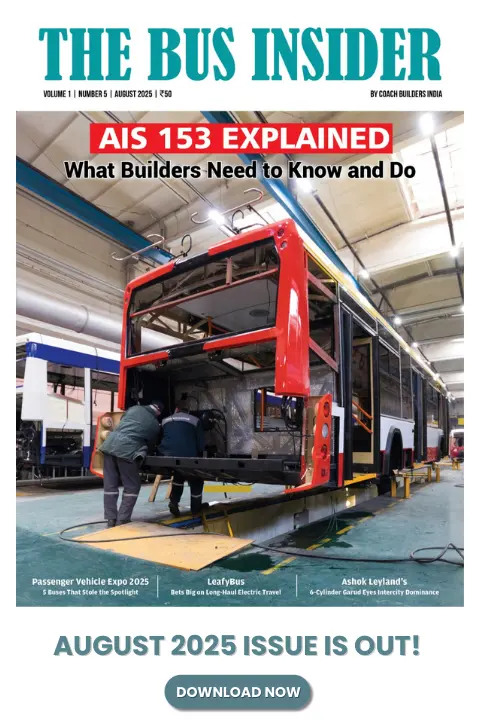Explained: What are Sky Buses in India and Will We Get Them Soon?
A look at the benefits of Sky Buses in India, the advantages and disadvantages, proposed routes, and countries with suspended monorail systems.

The Union government has long been considering the implementation of Sky Buses in India as a viable solution to escalating traffic congestion in our cities.
Of late, Union Transport Minister Nitin Gadkari has consistently voiced his aspiration to see this innovative transit system in operation across various routes.
The discussion surrounding Sky buses in India gained significant momentum when the minister personally experienced a safety and evacuation demonstration during a test ride in Sharjah in October 2023.
Visited the Pilot Certification and Experience Center of uSky Technology and took a test ride of the Sky Bus to experience the safety and evacuation demo in Sharjah, UAE, during my en route to India from Prague.
— Nitin Gadkari (@nitin_gadkari) October 4, 2023
uSky Technology has developed Sky Bus solutions, and iSky Mobility… pic.twitter.com/Hf0GT063Fi
Following Gadkari’s test ride, there is growing speculation about an imminent formal announcement regarding the launch of this service in India.
This prompts the question – What exactly is a Sky bus, and can we expect to see them in operation in India soon? This article delves into the details.
What is a Sky Bus System?
Unlike traditional ground-based transit systems, Sky buses operate on elevated tracks, offering a unique mode of transportation that utilizes vertical space.
They don’t take up as much space on the ground because they’re up in the air. This makes them a cost-effective way to help people get around in busy cities.
So, in simple terms, a Sky Bus is a suspended metro that travels high above the streets. This is why it’s sometimes called a suspended transit system.
Sky Buses achieve speeds of approximately 100 km/h and operate on electric power.
What distinguishes them from metro train systems is the reduced requirement for extensive civic infrastructure, leading to decreased operational expenses compared to conventional metros.
This innovative design employs gravity to enclose the vehicle’s wheels and tracks within a protective concrete structure, significantly lowering the risk of derailment and thereby reducing associated costs.
Sky Buses in India – A Brief History

India’s penchant for Sky Buses dates back to 2003 when former Prime Minister Atal Bihari Vajpayee unveiled India’s ambitious Sky Bus Metro project, a New Year’s gift to the nation.
The visionary plan aimed the inaugural launch of the Sky Bus technology in India in the scenic state of Goa, with a projected budget of Rs 100 crore. The initial phase was set to connect Mapusa to Panaji, covering an inaugural route of 10.5 km.
Indian technologist B. Rajaram spearheaded the Sky Bus Metro project in collaboration with BEML and Konkan Railway.
The system boasted an elevated track with cars suspended beneath, akin to Germany’s Wuppertal Schwebebahn or H-Bahn systems.
Trials commenced on a 1.6 km test track in Margao, Goa in 2004. Tragically, on 25 September of the same year, an accident claimed one life and left three injured, halting further trials.
Interestingly, Indian Railways obtained global patents for the Sky Bus in 2001 and 2004. The Indian President is the designated recipient of these patents.
Countries with Operational Suspended Monorail Systems
Elevated transportation systems like Sky Buses are not extensively utilized worldwide. Their implementation has been limited due to various challenges.
As of 2023, operational Sky Bus systems can be found in Japan, Germany, China, and the USA. Internationally, they are referred to as suspended monorail systems.
In Japan, two prominent suspended monorail systems are in operation – the Chiba Urban Monorail, boasting the world’s longest track at 15.2 kilometers, and the Shonan Monorail.
Germany hosts three operational suspended monorail systems – The H-Bahn, Dresden Suspension Railway, and the Wuppertal Suspension Railway. The Dresden Suspension Railway, which commenced service on May 6, 1901, stands as one of the oldest.
In the USA, the Memphis Suspension Railway, known locally as the Mud Island Monorail, is the sole operational suspended monorail. It was inaugurated on July 3, 1982, linking downtown Memphis to the recreational park on Mud Island.
The latest country to join the list is China. The inaugural commercial suspended monorail line in Wuhan, the capital of Hubei province, was unveiled to the public in September 2023.
Indian Railways obtained global patents for the Sky Bus in 2001 and 2004. The Indian President is the designated recipient of these patents.
Proposed Sky Bus Routes in India
India, striving for net-zero carbon emissions by 2070, sees a triumphant Sky Bus service as a major boost to its environmental endeavors.
Minister Nitin Gadkari, in early 2022, voiced intentions to launch Sky Buses in Bengaluru and Varanasi, aiming to alleviate city traffic.
Recently, addressing Prayagraj, he emphasized the city’s readiness for Sky Buses, expressing willingness to embrace global concepts for upgrading public transit.
Gadkari revealed that detailed project reports (DPRs) are in the works. He envisions the inaugural Sky Bus operation in Delhi and Haryana, foreseeing its positive impact on the capital and surrounding regions.
Pollution reduction remains a top priority, highlighting the government’s commitment to sustainable progress.
In January, a Philippines-based firm was commissioned to evaluate the feasibility and potential impact of the Sky Bus project in Bengaluru.
In October, 2023, Gadkari proposed a Sky Bus cable project in the holy city of Amritsar, specifically around the Golden Temple, to address traffic challenges in its narrow terrain.
What Will be the Benefits of Sky Buses in India?
Sky Bus technology in India will offer several advantages over traditional forms of transportation, such as buses and trains. They are faster, more environmentally friendly, safer, more accessible, and can help to mitigate traffic congestion.
According to a study by the MIT College of Management titled Sky Bus: The Modern Transportation System, some of the key advantages of sky buses include:
- Less Expensive: Sky Bus infrastructure is cheaper compared to traditional metro systems.
- Swift Transportation: Passengers can expect air-conditioned travel at high speeds of up to 100 km/h, with Sky Buses arriving every two to three minutes. This system covers distances at an average speed of around 45 km/hr.
- Minimal Land Acquisition: The implementation of Sky Bus technology in India requires minimal land acquisition, primarily for ensuring the right of way on existing roadways.
- Vandalism Resistance: Sky Buses are not vulnerable to vandalism, as the track and moving gears remain inaccessible.
- Stability: In the event of a derailment, the coach remains suspended and cannot fall, ensuring no risk of capsizing, a distinct advantage compared to conventional railways and underground metros.
- Sharp Turning: Sky Buses can take sharp turns which cannot be imagined in a standard gauge metro.
- Environmental Friendliness: They are aesthetically pleasing, produce no noise pollution, and are environmentally friendly.
- Comfortable Travel: All Sky Buses are air-conditioned, providing passengers with a comfortable experience.
- Accessibility: The system includes lift facilities for the convenience of seniors and differently-abled individuals.
In addition to these advantages, Sky Buses can also help to improve the aesthetics of a city. Sky Bus systems can be designed to be visually appealing, and they can help to create a more modern and futuristic look for any city.
Disadvantages of Sky Buses
While Sky Buses offer several advantages over traditional forms of transportation, they may have some disadvantages as well. Here are some of the disadvantages of sky buses:
- High Initial Cost: The cost of building and operating Sky Bus systems is high. This can be a barrier for cities considering implementing such systems.
- Limited Flexibility: Sky Bus systems are typically fixed-route systems, which means they cannot be easily rerouted to meet changing demand. This can be a disadvantage in cities with unpredictable traffic patterns.
- Maintenance Costs: Sky Bus systems require regular maintenance. As a technically advanced transit system, maintenance can be expensive.
Despite these disadvantages, sky buses offer a number of advantages that make them a viable option for cities that are looking to improve their transportation systems.
Will We Have Sky Buses in India Soon?
The Indian government is considering implementing this transit system in several cities, including Delhi, Mumbai, and Bengaluru. The Union Government is also in talks with various international companies to introduce Sky Bus technology in India.
Union Minister for Minister for Road Transport & Highways, Nitin Gadkari has revealed in a tweet that iSky Mobility has partnered with uSky Technology to bring Sky Buses to India.
Visited the Pilot Certification and Experience Center of uSky Technology and took a test ride of the Sky Bus to experience the safety and evacuation demo in Sharjah, UAE, during my en route to India from Prague.
— Nitin Gadkari (@nitin_gadkari) October 4, 2023
uSky Technology has developed Sky Bus solutions, and iSky Mobility… pic.twitter.com/Hf0GT063Fi
While there are challenges as discussed above, the Indian government has already made its commitment to developing sky bus technology in India apparent.
If the government is successful in addressing the challenges to sky bus implementation, we may see sky buses operating in India in the next few years.
Catch the Latest Bus Industry Updates, Exclusive Interviews, Bus News, and International Bus News on Coach Builders India. Download the latest issue of the The Bus Insider magazine for industry insights.







